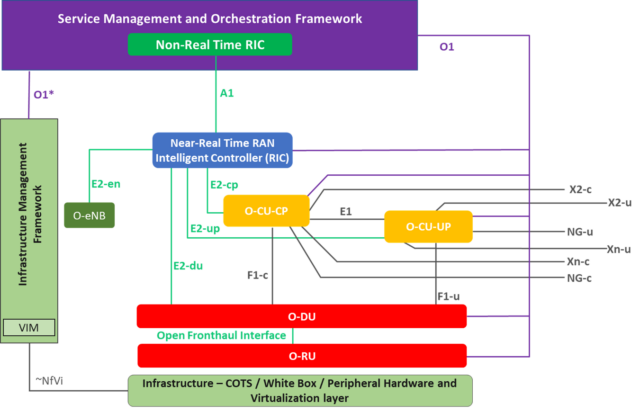This blog is co-authored by Ravi Calyanakoti, Principal Systems Architect, Dell Technologies.
In our last blog, Operational Considerations for Open RAN, we looked at the operational capabilities telecommunications operators need to adopt in order to effectively deploy vRAN and Open RAN systems. But deployment, of course, is only the first part of the journey. Once 5G RAN systems are operational, they need to begin delivering and maintaining 5G services, which requires additional capabilities such as service management and orchestration (SMO) and intelligent control.
Service management and orchestration goes beyond infrastructure automation (covered in our previous blog) to automate how services are managed and delivered in a heterogeneous network. The standards for Open RAN, as set forth by the O-RAN Alliance and other industry groups, provide for much more automation than is found in a traditional RAN system. The SMO solution and RAN Intelligent Controllers (RICs) manage this extreme automation, which we’ll cover later in this blog.
The SMO provides a central interface for application configuration and provisioning. It also automates both infrastructure management processes and the creation of new services through southbound APIs (O2-IMS & O2-DMS). In addition, SMOs help manage and orchestrate software, including FCAPS (Fault, Configuration, Accounting, Performance and Security) over O1 interface. A third interface in the SMO, known as an A1 interface, is used to manage policies and artificial intelligence/machine-learning (AI/ML) model updates via the near real-time (RT) RIC.

One of the key advancements in the Open RAN system is the presence of new network elements known as RAN Intelligent Controllers. There are two types of RICs defined in Open RAN: the non-RT RIC, which controls applications that can tolerate one second or more of latency, and the near-RT RIC for applications that require sub-second responses, often in the range of milliseconds. RICs are responsible for collecting network data from the RAN, applying AI/ML algorithms and working together with the SMO to support closed-loop processes such as real-time video optimization and dynamic spectrum sharing.
While Open RAN systems are exceptionally flexible and scalable, they can also be complex to manage and integrate. In a vRAN/Open RAN architecture, the traditional integrated baseband unit (BBU) is now divided into several elements – specifically, the radio unit (RU), control unit (CU- Virtualized) and distributed unit (DU-Virtualized). These elements need to be integrated and validated together by the telecommunications operator or their vendor(s). In the frequent case of a multi-vendor vRAN/Open RAN architecture, this means integrating and validating components for every possible configuration.
Infrastructure isn’t the only consideration for multi-vendor integration. Multiple vendors can deliver applications such as rApps and xApps, which provide RAN intelligence for policy enforcement and analysis, thus requiring integration. The non-RT RIC manages rApps and near-RT RIC manages xApps. In addition to RIC integration and validation, these apps need to be interoperable with a wide variety of vendor solutions, including the underlying hardware for the various network elements (e.g., hardware accelerator and network interface cards) and the cloud platform software.
Creating Peaceful Co-existence with Legacy Systems
So far, we’ve talked primarily about the integration capabilities for multivendor 5G RAN systems. But what happens when 5G network elements need to interact with legacy 4G, 3G and even 2G systems? Most established telecommunications operators will have legacy RAN equipment in their networks for the foreseeable future. This can result in multiple management layers, which can create interoperability issues and exponentially increase management complexity. In order to bring multi-generational RAN systems into a unified management interface, legacy operational support systems (OSS) will need to be migrated to an SMO platform as part of wider Open RAN adoption.
While Open RAN integration is an important consideration for telecommunications operators, it shouldn’t be perceived as a barrier to innovation. Industry groups such as the O-RAN Alliance and technology leaders, including Dell Technologies, are working with telecommunications operators and vendors alike to create integrated, validated, open 5G RAN solutions. Only by opening up 5G to the broadest possible group of technology vendors can operators hope to reduce costs and accelerate innovation.
Today, Dell Technologies is helping to lead the way to an open 5G future with a wide portfolio of solutions including:
-
- Bare Metal Orchestrator (BMO) for infrastructure automation and zero-touch provisioning.
- Dell Telecom Infrastructure Blocks for pre-integrated, cloud-native, turnkey solutions for vRAN and Open RAN deployments.
- Open Telecom Ecosystem Lab for integration testing of vRAN and Open RAN components.
- The Open Telecom Ecosystem Lab Solution Integration Platform for CI/CT/CD-based automation, continuous integration, testing and deployment of 5G solutions.


